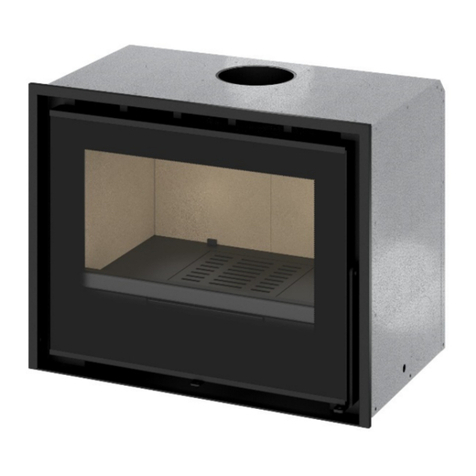
Important Recommendations:
Important:
oThe compartment below the combustion chamber should not be used to store combustible materials.
oPlease read this manual thoroughly before installing and starting your free-standing appliance.
oInstallation must be carried out by a licenced and certified installer.
oKeep these instructions for future reference
Before installing your appliance, you should ensure the following:
1. When installing the appliance, all local regulations, including those relating to National and
European standards, must be observed.
2. The appliance must be installed on a non-combustible, non-flammable surface.
3. The base / ground for the appliance shall have adequate strength to support the load of the
appliance.
4. If the appliance is to be suspended from a wall, you must be sure that it is not combustible or
flammable, and that it can support the weight of the equipment with the pipe and load of
firewood. The installer is responsible for assessing the wall with adequate load capacity
5. If necessary, place insulating material between the appliance and other surface to be protected
(e.g. tile walls must be protected);
6. Particular attention should be paid to the installation of smoke ducts, as they reach high
temperatures - they should not be near or in contact with combustible or flammable materials.
7. The environment in which the appliance is to be installed must be well ventilated to ensure the
amount of air required for combustion.
8. Respect the safety distances to combustible and flammable materials indicated in this manual
page 13.
9. Your appliance must be non-permanently installed and easily accessible to ensure general
maintenance (chimney and appliance);
10. A disconnecting means must be provided in the fixed electrical installation, in accordance with
the electrical regulations. - Apply an all-pole cut-off switch in the fixed electrical installation.
11. For well insulated houses or forced air ventilation in the kitchen or bathrooms, it is advisable to
place a ventilation grid on an outside wall near the appliance. This safety mechanism is important
to prevent the air in the room from draining and to prevent smoke from the chimney. The
outdoor area of the grate must be at least 100cm2and always be open and unobstructed.
12. The appliance must be installed on a non-combustible non-flammable surface.
13. In freestanding appliances, the compartment below the combustion chamber should not be used
as a fuel or flammable material.
14. Freestanding heaters shall be laid on a non-combustible surface with adequate strength (in the
case of stone or other equivalent at least 6cm high) where the ends extend at least 80cm from
the front.
15. It is recommended to place grates ouside the walls surrounding the appliance to cool it (in the
upper and lower areas) with a minimum cross-section of 350cm2.
16. It is important that you use your appliance in a moderate manner; the first firings should be
made with a low amount of wood and with a not too intense flame, to favor the dissipation of
the metal tension and let the paint cure slowly, so it does not present imperfections later;
17. During the first use curing of the paint occurs - emanation of odors may occur. Avoid inhalation
and ventilate the surrounding space properly.
18. The first firing is very important, as it favors the longevity of the painting of the appliance. In this
way the ignition should be smooth and never abrupt, it should not exceed 200ºC in the first 60

























